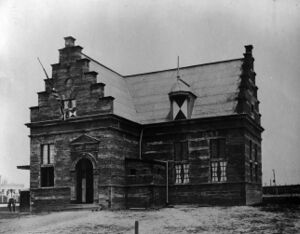Holland: Difference between revisions
(Created page with "{{short description|Holland National Pavilion}} {{Infobox prepared food | name = Holland National Pavilion | image = Holland National Pavilion.jpg | image_size = 300px | caption = Holland National Pavilion | alternate_name = | country = | creator = | course = | cost = $5,000 ({{Inflation|US|5,000|1904|fmt=eq}}) | admission = | profit = | owner = | main_ingre...") |
No edit summary |
||
| Line 16: | Line 16: | ||
| variations = | | variations = | ||
| calories = | | calories = | ||
| other = | | other = | ||
}} | }} | ||
Revision as of 01:29, 10 November 2022
 Holland National Pavilion | |
| Construction Cost | $5,000 (equivalent to $150,796 in 2021) |
|---|---|
Holland's small National Pavilion was on the site formerly allotted to Russia and abandoned by that country when war had begun with Japan. It occupied a space 50 by 40 feet, and showed on three sides steep-pitched Dutch gables with corbie-steps on the slopes.
Etymology
Before the Fair
Description
While not an exact copy of the home of Rembrandt, the building is a perfect piece of sixteenth century domestic architecture, and is a curio shop of old furniture. Delft pottery and silver. In one of the rooms is an exact size reproduction of the most famous of all Rembrandt's paintings, the one that has been called "The Night Watch," copied by Hendrik Kleyn, which was in the State Museum at Amsterdam at the time. An admission fee was charged to view the picture.
The other parts of the building were free and contained fine antique Holland furniture. A typical Dutch garden surrounded the structure.
